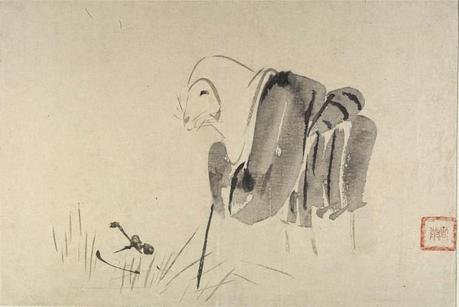by Nina

A Mouse as a Monk by Shibata Zeshin
“It is quite possible that it will dramatically increase the incidence of cancer,” said Irina M. Conboy, a professor of bioengineering at the University of California, Berkeley. “You have to be careful about overselling it.” —New York TimesAs if to prove one of the points I made in my post just last Monday What is Aging, Anyway?, a recent article in the New York Times announced a new study on aging research Young Blood May Hold Key to Reversing Aging. Yes, they went right ahead and used the “r” word, one of the words that I said should set of alarm bells.
But I try to keep up with the latest developments in research on aging and the article was the New York Times after all, so I went ahead and read it (oh, the things I’m forced to do for this blog). Of course, the “young blood” thing turned out to be more complex than headline implied. In fact, the research was specifically about adult stem cells—in mice, of course.
Adult stem cells keep our tissues healthy. When there is damage to a part of the body, stem cells move in and produce new cells to replace the dying ones. But as we—and mice—get older, our stem cells don’t work as well. (Have you noticed how much longer it takes to for you to heal after a muscle tear or even a simple scrape?) It’s not that the number of stem cells is lower in older bodies, it’s just that, as Thomas A. Rando, professor of neurology at Stanford University School of Medicine put it, “They just don’t get the right signals.”
Wondering what signals the old stem cells would receive if they were bathed in young blood, Dr. Rando and his colleagues experimented by joining old and young mice for five weeks (literally joining them together—see NY Times article for the gruesome details). After five weeks, the muscles of the old mice had healed about as quickly as those of the young mice, and the old mice had grown new liver cells at the rate of younger mice. What could be causing this? A member of Dr. Rando’s team, Dr. Wagers continued to study the blood of young mice after she moved in 2004 to Harvard, and last year she and her colleagues demonstrated that the young blood could rejuvenate the hearts of old mice. After they found that a protein called GDF11 that was abundant in young mice and scarce in old ones, the scientists injected GDF11 into old mice. And they found that even on its own, GDF11 had the same positive effective the hearts of the old mice. Then they did a similar experiment on skeletal muscle in mice, and found that GDF11 revived stems cells in old muscles as well, making old mice stronger and increasing their endurance.
At this point, I was actually feeling—despite the ultra gross details of how the old and young mice were sewn together—a bit excited. Imagine if we could take some kind of GDF11 supplement that would rejuvenate our aging organs, muscles and bones? But, WAIT! At the very end of the article, the author concluded by saying that scientists would need to take care in rejuvenating old body parts—waking up stem cells might lead to their multiplying uncontrollably. Hence the Conboy quote at the beginning of this post, warning of possible increases in cancer. Skepticism turned back to the ON position, I consulted our resident expert on aging Dr. Brad Gibson for his opinion on this latest claim about “Reversing” aging. And here’s what he said:
"I would agree with Conboy about the possibility for adverse effects. Especially cancer, as there is growing evidence for the role of dormant stem cells that become activated in breast and other cancers leading to metastasis. And if young blood—now containing among other things an elevated level of GDF11—is introduced into an aged background, are we going to be stimulating (previously dormant) cancerous stem cells as well?
"It's akin to if we just now had discovered human growth hormone (hGH) and realized that it too goes down with age, and increasing would restore some young phenotype (more energy, more muscle mass, etc.). Turns out hGH has lots of bad side effects—including an increased risk of cancer as well as cardiovascular diseases —and it also was once (and still is to some) claimed as a 'rejuvenating" or 'anti-aging' substance. Overall, very interesting and potentially ground breaking science, but it begs the question why we feel compelled to go around making absurd and/or over-reaching claims before we really know about its other effects? It’s possible that GDF11 levels go down with age to limit cancer stem cell becoming activated, albeit at a high price of a loss of tissue repairs capabilities. Or not..."
Excuse me while I go practice a yoga for upper body strength sequence now….
Subscribe to YOGA FOR HEALTHY AGING by Email ° Follow Yoga for Healthy Aging on Facebook

